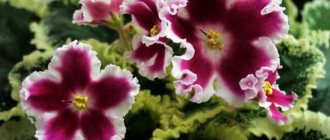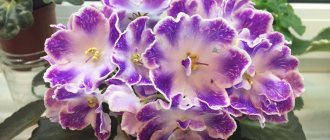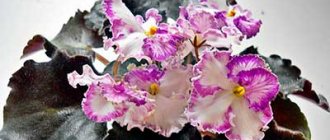Description
Violet Zlato Skifov (LE) is distinguished by large double flowers of white-yellow color with a pink uneven border. The blooms look stunning when contrasted with the dark green foliage. The flower stalks are strong enough to support large flowers.
Violet Zlato Skifov
In a flower that has not yet fully bloomed, the petals often have a light, monochromatic color that looks golden in certain lighting. Brighter color appears as the plant grows and develops.
AB Gold of the Scythians
Among similar varieties of Saintpaulia, one can distinguish the varieties “LE Zlata” and violet “Gold of the Scythians AB”. Moreover, the violet of breeder Alexei Valkov is almost identical, except that the border is pink in a more delicate shade.
Violet "LE Zlata" was released in 2022. The main difference between this variety is the purple border.
This is interesting: the Scythians are the largest tribe living in the territory of what is now Ukraine and Moldova in the 1st millennium BC. A unique collection of Scythian gold is kept in the Museum of Historical Treasures of Ukraine.
Flowering period and characteristics
Most varieties of Elena Lebetskaya, including Zlato Skifov, form buds according to the bouquet type - in the center of the bushes, almost simultaneously, regardless of the season. Fans only need to help the plant a little to make the hat especially lush.
But this type of flowering has a downside. The violet is at the peak of its decorativeness for 45-60 days, then it rests for the same amount of time and produces new buds, which also need time to open. With good care there will be 3 waves of flowering per year.
You can force Zlato Scythians to bloom gradually - almost constantly putting forward sparse flower stalks located at an angle to the leaves. But this way the violet will lose most of its attractiveness.
The plates of the cultivar do not fit tightly together, but amateurs often complain that the buds have difficulty making their way to the light. Usually the situation is resolved in one of the following ways:
- They remove some of the leaves, which is not very good. The number of buds that can open and last a long time on a violet directly depends on the number of plates that provide photosynthesis and nutrition.
- Peduncles are pulled out by hand. Troublesome, but reliable.
Features of violet care Zlato Skifov
Violets Zoloto Scythians (AV) and Zlato Scythians (LE) are almost identical in care:
Violet Shining bell - description of the variety
The most important rule for maintaining color saturation and the appearance of the border is maintaining the temperature regime. For any Saintpaulia, temperatures above 30 degrees are fatal. As for varietal specimens, during the period of flower stalk formation it is best to maintain the temperature from 17 to 23 degrees. Scythian gold in cooler conditions often exhibits a green border.
Attention! The myth that violets love shade has destroyed a considerable number of plants.
The lighting of the violet must be correct. Saintpaulias love bright but diffused light. Lack of lighting leads to a lack of flowering and leaves stretching upward. And at the same time, too intense sun can burn the leaves. Therefore, it is best to shade southern and south-eastern windows with blinds or glue special paper to the windows. In winter, it is important to organize lighting.
Violets of these varieties do not like excessive watering, as well as severe drought. The soil is watered as the top layer dries a centimeter. The water should be settled and not cold. As for wick irrigation, the requirements are similar.
Important! Spraying the flowers or leaves is not necessary and may even ruin the plant.
But periodic bathing removes dust from sockets. You can wash the violet directly under the tap, gently tilting the leaves. After this, the pot is left in a place without drafts to dry for a couple of hours. When bathing, the ground should be covered with film.
High humidity, contrary to popular myth, is not needed at all by violets. Moreover, in low temperature conditions, excessive moisture can lead to rot and mold. During the heating season, if dry tips begin to appear on the leaves, it is best to use a humidifier (it is useful for both flowers and people).
Soil is the most important rule in successfully growing the LE Zlato Skifov flower. Ordinary soil will not work because it gets wet quickly. The ideal solution is high-moor peat (40 percent) and ripper (perlite, foam balls, vermiculite).
Any variety of Saintpaulia requires frequent fertilization and soil changes. With a lack of nutrients, the Zlato Skifov violet loses the rich color of its leaves, does not bloom, or the buds become smaller.
By following all the rules, you can achieve perfect flowering.
Violet Ecstasy: description of the variety and characteristics
Violet Ecstasy: photo of the variety
The characteristics of violet AB Ecstasy are very brief: it is low herbaceous vegetation. The leaves are green in color, slightly wavy, grow on low stems, forming a rosette at the roots. The flowers are velvety, white and light green in color, and can delight with their attractiveness for quite a long time. The violet was first discovered in the tropics of Africa. The scientific name is “Sainpaulia”, derived from the name of Saint-Paul, the baron who discovered this culture.
In 1892, he discovered a flower in huge stones; the violet was sent to his father, a collector of rare vegetation. And the Uzambara culture is because this name is consonant with the place in Tanzania, it was there that Saint-Paul discovered the plant while walking with his beloved. Next, the violet variety Ecstasy was exhibited in magazines, print publications, and exhibitions, which contributed to its wide distribution and popularity on a global scale.
How to propagate Zlato Skifov violet at home
What a violet looks like - description of the plant
Saintpaulia can be propagated in three ways:
- Seeds. The option is most often used by breeders.
- Leaf cuttings.
- Peduncles (in the case of chimeras).
The most common option is to take a leaf cutting. It should be cut with a sharp blade (wipe with alcohol); the leaf is needed from the second row. You need to choose specimens without stains or defects.
Next, you need to either put the cutting in water until roots appear (then place it in the ground), or immediately root it in the ground.
To do this, pour a mixture of perlite and peat in a ratio of 60 to 40 into a small plastic glass. Place the sheet to a depth of up to a centimeter and strengthen it in the ground. After this, it is better to place the cuttings in a greenhouse - here the processes will go faster.
Rooting a violet leaf
After about 2 weeks, the leaf will take root, and in a month - babies. The latter should be planted as soon as at least 4 leaves of at least 2 centimeters in size have grown.
Incorrect planting of violet babies
Violet Wild cherry (T. Dadoyan)
Mysterious violet Wild cherry.
At first glance, this representative of Uzambara violets captivates with its unusually bright appearance .
Thanks to Tatyana Leonidovna Dadoyan, who gave this miracle to flower growers . She does not consider herself a breeder, as she primarily creates creations for herself. Each of them contains a piece of her soul. If you bring Wild Cherry into your home, it will warm you with warmth.
Important! Wild Cherry is a sport derived from Frost Cherry. Let us recall that sport is a vegetative mutation characteristic of Saintpaulias. The cherry color of the flowers became the reason to give it this name.
Meet the violet Wild Cherry :
- Family - Gesneriaceae;
- Genus – Saintpaulia hybrid;
- Flowers : Large;
- Semi-double;
- Cherry;
- Bright, with a variable white border.
Replanting after purchase
If you purchased an adult plant or a baby plant, then they need to be replanted immediately, since the soil may be unsuitable. Choose a container that is approximately 2 times smaller than the outlet. If we are talking about children, you can take 50 ml plastic cups (for example, for children's cottage cheese).
Transplanting violets after purchase
You must make holes at the bottom. Next, expanded clay is poured in and covered with earth.
Note! The violet should be in the container at such a level that the midpoint of growth rises slightly. Place the rosette in the middle and carefully add soil to the sides. Lightly compact.
Requirements for violets to bloom
Without proper maintenance, Saintpaulia does not bloom, is susceptible to fungal infections, and may die. It is very demanding when it comes to watering, which differs from how other indoor flowers are watered, lighting, container, soil and temperature. It is necessary to regularly feed the flowers, trim them, and replant them only in new soil.
Genetic component
When choosing indoor Saintpaulia, take into account the variety. Breeders have developed many varieties. Among them are ampelous ones with small, medium or large flowers. There are violets with 5 petals, while others have many more and no stamens are visible. Also, some varieties produce only 3 buds and will not bloom magnificently. You can wait for the violets to bloom for several months or 1.5 years. Depending on the variety, the duration of flowering also varies.
Selecting the right container
For a small Saintpaulia, a pot 5-7 cm in diameter is suitable, for an adult flower 10-12 cm. In general, you need to look at the outlet and take a container with a diameter half as large. The height should be no more than 10 cm.
Correct soil
Saintpaulias require slightly acidic soils. Purchase special soil from a flower shop. It is not difficult to make the soil correctly; it is leaf soil, peat, charcoal, moss (1: 2: 1/2 : 1/2). Or sift garden soil, combine it with sand and bake it in the oven. Expanded clay and small pebbles are placed on the bottom. Transplantation is required once a year, into fresh substrate.
Location
Saintpaulia is placed on the western or eastern side. In winter there is not enough light on the windowsill from the north, in summer from the south there is too much sun, the violet is shaded or rearranged. To avoid hypothermia of the roots in winter, place the flower in a pot on a shelf, table, in a flowerpot or on a wooden stand.
Lighting
Violets prefer at least 10 hours of daylight; they need diffused light; direct sunlight shades the flowers. At the same time, varieties with thick and dark leaves require more bright light than those with curly leaves. If the flower stretches out, the foliage curls, and becomes pale, there is not enough light; if the middle of the rosette is denser, there is a lot of light. When the leaf blades are bright, rich in color and there are a lot of buds on the plant, the lighting is normal.
Temperature
The plant loves high temperatures. From the beginning of spring to autumn, flowers need +20...+22 °C. In winter, not lower than +18…+20 °С. In summer, when +30 °C, the flower fades and becomes smaller. Therefore, the room is ventilated, using air conditioning and a split system. There are no drafts in the room.
Air humidity
Violets are given high humidity, 50-60%. For the winter, it is better to remove the pot from the windowsill if there is a heating system nearby. The air around the flower is sprayed without getting on the inflorescences. Place the container with the flower in a tray with wet expanded clay and pebbles. With low humidity, the buds develop slowly.
Watering methods
There are secrets for watering Saintpaulias. Take slightly warm, settled water. Water as the soil dries so that liquid does not fall on the leaf blades, the growing point.
Through the pallet
Water at room temperature that has been standing for 24 hours is poured into a tray to ¼ of the height of the flowerpot. Half an hour is usually enough for the plant to be saturated with moisture, this will become clear from the soil. Then the remains are drained.
Drip
For this, a watering can with a narrow spout and a syringe bulb are used. If there is nothing, a plastic bottle will do, where a hole is made in the lid and a straw is inserted. When water begins to flow out of the drainage, stop watering and then drain it. If moisture gets on the leaves, blot them with a dry cloth.
Wick
In the summer, when you need to leave and there is no one to care for the flowers, this method is suitable.
A thin cord (household cord, acrylic thread, shoe thread) is placed in the pot; one end comes out through the drainage hole, the other is folded into a ring in the middle of the soil. Place the pot on top of a bowl of water covered with a lid, lower the wick, and the soil collects the required amount of liquid.
The main problems of violets Zlato Skifov
What problems might a gardener face who wants to grow this interesting variety?
- Dark spots on the leaves mean excessive soil wetting and possible problems with the root system. It is necessary to inspect the roots. If they are normal, then we transplant the flower into suitable soil. If they are brown, but the stem is strong, we clean it with a knife and plant it again in fresh soil. A black stem and soft cuttings mean the death of the rosette. Brown spots on the leaves remain when exposed to moisture and further drafts.
- Bacteriosis is manifested by a gradual darkening of the trunk and cuttings; over time, they rot completely. Most often, the disease begins in the heat and affects plants with weak immunity. Therefore, before the onset of summer, it is important to put the collection in order - re-root diseased rosettes, change the soil to light, etc.
- Spider mites often attack Saintpaulias. You can buy a lot of destruction products in stores, but the flowers will have to be removed. When processing, it is important to rinse window sills and pots well.
- Mealybugs most often appear in conditions of high humidity. You can also buy a drug to kill the pest in the store.
With proper care, the violet Zlato Scythians or Zoloto Scythians will definitely thank you with lush and bright flowering. At the same time, the unusual appearance of flowers will certainly amaze other flower lovers and ordinary people.
Possible diseases of violet AB Mother's heart
Violet Mother's Heart: photo
Violet The mother's heart may show signs of disease if the rules for caring for the crop are not followed. Direct sunlight will cause burns and yellowing of the leaf plates. If the growing temperature for violets is low, this can cause the fungal disease Fusarium. Rotting of the green mass and root system, as well as the formation of mold, appear when there is an excess of water in the soil. In addition, ashtray fungus occurs periodically.
The most common pests of violets AB Mother's Heart: aphids, mites. In this case, the infected areas are cut off, and the Mother’s Heart violet itself is treated with special medications.
Features of the variety
Regardless of what species this variety belongs to, the flowering period of the Milky Way violet begins approximately 8 months after the cuttings are planted in the soil. This flowering continues for about three weeks and ends with a short break. In adulthood, a plant regularly produces new flower stalks, plus a very large number of stepsons are formed that interfere with the flowering of the plant, which is why they need to be removed in a timely manner. When a sport appears, that is, a plant that has undergone a vegetative mutation, you can see dark purple petals on the flowers, and the spots themselves in this case are completely absent on such petals.
Possible problems during cultivation
Often the plant is attacked by pests and diseases. The prerequisites for their appearance are improper care and violation of conditions of detention.
A healthy plant blooms long and luxuriantly
Diseases
Violets often suffer from root rot. This is a consequence of keeping the plant at a low temperature and excess moisture in the substrate.
A dangerous disease is vascular bacteriosis, which develops at high air temperatures and is characterized by transience. The leaves begin to turn black and rot.
Powdery mildew can slow down the development and flowering of a plant or even destroy it. With this fungal disease, the leaves and shoots begin to become covered with a white coating.
Pests
Insects can cause damage to violets - aphids, scale insects, thrips, scale insects and mites. By infecting the plant and feeding on its sap, they prevent its normal development. If left untreated, the flower may die.
Signs of improper care
If the conditions of care are violated, the appearance of the leaves and shoots of the violet changes. A healthy plant has juicy, elastic foliage, without signs of sunburn and damage by parasites and diseases. Problems are indicated by drooping, rotten leaves, plaque on them, or a prolonged lack of flowering.
Proper care will help you admire the blooms longer
Violet VaT Tsar Pea is a selection variety of Saintpaulia. This is a lush flowering plant with large flowers and decoratively framed foliage. A characteristic feature of a violet is the color of the flowers: on the white petals there are large purple spots, reminiscent of a fingerprint, and small pink spots in the form of peas are scattered across them.
Fialka vat King Pea decorates any room and attracts attention during flowering. Caring for the plant is not difficult, you just need to follow the basic recommendations.
Violet Luntik: reviews
Violet LE Luntik: photo
Violet growers, flower growers and housewives who are passionate about growing Luntik violets always speak positively about it. Seventy percent like the small and neat rosette, as well as the unusual and rich coloring with colorful splashes. The main disadvantage of the violet variety LE Luntik is the loss of some characteristics of the variety during the breeding process. The variegation is lost first.
All beginners should pay attention to the Luntik violet, this is an ideal plant for beginning flower growers; it is beautiful in appearance, the bright colors are pleasing to the eye, and the ease of care will give you confidence and strength to continue growing violets of other equally interesting varieties.
Care techniques in indoor culture
The violet has an enviable pickiness of character - it gratefully responds to the clear and regular implementation of simple agricultural techniques with good growth and lush flowering:
- The plant follows display on the windowlooking west or east; specimens from windows to the north should be provided with additional rays with a diffuse spectrum, to the south - unobtrusive artificial protection is required;
Saintpaulia requires proper care. - Watering the violet is indicated in small doses from the moment when a slight drying of the upper volume of the substrate is visually clearly visible;
- It is best to apply additional fertilizing with mineral fertilizers
- light to the violet predominantly during the day, long-lasting, with a spectrum of scattered rays;
- Control a constant heat level within +18 + 20°C; eliminate sudden fluctuations in the temperature gradient;
- Plant the rosette in nutritious, permeable soil with good aeration; ensure the creation of a volumetric drainage layer;
- When transplanting violets, use transshipment more often if there are no special indications.
A detailed look at life stages
The main life processes of varietal violets mostly correspond in timing to the course of these biological phases in many tropical beauties of the genus, which greatly facilitates plant care.
Florists can:
- Draw up schedules of modes according to a general model;
- And then adjust them in accordance with the specific nuances of the variety.
Features of development in indoor collections
The varietal Saintpaulia in the home collection shows its best qualities , without causing trouble for gardeners when they carry out agrotechnical procedures and without being particularly picky about certain microclimate conditions in the room.
ATTENTION! The variety blooms beautifully with normal care, if you do not forget about some of the specific features of this exotic guest.
The favorable characteristics of the variety include the following useful qualities :
- Independent and harmonious design of a maturing leaf rosette;
- Quite fast growth rates of the bush in the initial phases;
- Simple vegetative propagation;
- Enchanting flowering with the formation of voluminous caps and a long phase of preserving the decorativeness of flowers;
- The first flowers are large in size and double structure;
- Strong flower stalks;
- Unique lace configuration of flowers of significant size;
- Minor reaction to minor violations in containment regimes.
Distinguished by numerous positive features, the variety cannot but have at least several negative aspects of development , like a true indoor plant:
- The need to maintain the decorative effect of flowers is slightly cool in the room;
- Slow, “slow-witted” development in the young bush phase;
- Control over the intensity of lighting - without sufficient light, cuttings and flower stalks are stretched;
- Deviation of sheet plates from an even position in the rosette due to their waviness;
- Gradual enhancement of the author's flowering characteristics to maximum manifestations;
- A specific drawback regarding exhibition Saintpaulias is their non-transportability due to the waviness of the leaves and the easy damage of the white corollas.
Specifics of reproduction
only two vegetative techniques at their disposal to obtain young specimens :
- Children from leaf cuttings;
- Stepchildren from the mother plant.
Propagation of violets using seeds is unjustified due to the danger of losing the variety.
Flower response to temperature
The peculiarity of the variety is the need for some coolness for the best decorative effect of snow-white flowers:
- In a very cool microclimate, the variety prefers to leave buds in the form of terry “heads of cabbage”;
- And with slight warming, the flowers open to the half-opening stage.
Heat does not affect only the presence of green edging of the petals, which does not disappear when exposed to heat. White flowers in hot conditions :
- They acquire brownish spots;
- And they fade much faster.
CAREFULLY! Violet flowers and buds fall off when exposed to thermal changes and drafts!
Pedicel strength
Saintpaulia's flower stalks are different:
- Thick structure;
- Massiveness;
- By force;
- And optimal growth.
Flowering type
Saintpaulia blooms in a cap type , gradually gaining maximum volume and lace texture.
The variety in question has cap flowering.
Lifespan of a flower
Under optimal conditions, each flower can maintain its decorative freshness for about a month.
Temperature
The optimal temperature is 20-24 degrees. Young Milky Way violet plants can be grown at temperatures 2-3 degrees higher, which will speed up the formation of rosettes. But heat is strictly contraindicated for adult bushes.
In winter, it is recommended to reduce the temperature by 3-4 degrees. The critical temperature is 16 degrees. Violet can withstand short-term cool conditions if the temperature drops gradually. During a long cool period, plant growth stops completely, the leaves begin to lose their turgor. Subsequently, irreversible processes occur in the plant tissues, which lead to the death of the plant.
You cannot keep the plant on a cold windowsill in winter, as when the root system is overcooled, it begins to rot.
Planting a crop
The container in which the plant will be planted is pre-filled with drainage. After this, the substrate is poured on top. The violet must be placed in the middle of the pot and the soil must be added evenly. It is noteworthy that during this process, the container needs to be slightly shaken. This measure is needed to fill all the voids in the pot with the substrate. It is recommended to fill the container not to the very top, but to leave about 2-3 centimeters unfilled. After planting, lightly press the surface and then water the crop.











